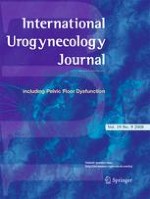Published in:

01-09-2008 | Original Article
Moderate weight loss in obese women with urinary incontinence: a prospective longitudinal study
Authors:
Wael Auwad, Pippin Steggles, Luigi Bombieri, Malcolm Waterfield, Terrance Wilkin, Robert Freeman
Published in:
International Urogynecology Journal
|
Issue 9/2008
Login to get access
Abstract
This study assessed the effect of moderate weight loss in obese women with urodynamically proven urinary incontinence using the International Consultation on Incontinence recommended outcome measures. Sixty-four incontinent women were offered a weight reduction programme with a target loss of 5–10%. This included a low-calorie diet and exercise. An anti-obesity drug (Orlistat) was offered to those who failed to achieve their target. Forty-two (65%) achieved the target weight loss and had significant reduction in body mass index and girth. Weight loss was associated with significant reduction in pad test loss (median difference, 19 g; 95% confidence interval, 13–28 g; p < 0.001). There was also a clinical and statistically significant improvement in quality of life measures. These results suggest that weight reduction of 5% of initial body weight can improve urinary incontinence severity and its effects on quality of life in obese women.